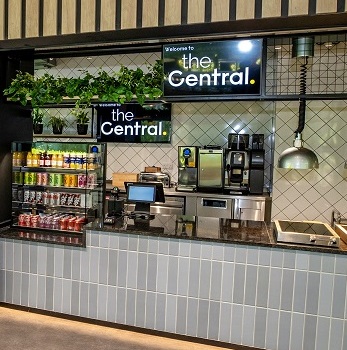Designing the till area of a catering facility requires careful planning to ensure efficiency, functionality, and a positive customer experience.
The choice of payment solutions is diverse, including wall-mounted kiosks, self-serve tills, staff-operated tills, table QR scan-order-pay systems, as well as mobile payment options.
Susie Cullen, the Head of Catering, Hospitality & Events at Anglia Ruskin University (ARU), successfully unveiled this summer two newly refurbished campus catering outlets equipped with Uniwares point-of-sale systems.
Susie Cullen comments, ‘We wanted to upgrade our EPoS solutions as part of our refurbishment initiative.

The ARU refurbishments have brought about transformative changes. These upgrades have not only streamlined the flow of customer traffic, resulting in an enhanced overall experience for students, but they’ve also enhanced the working environment for staff too.
Let’s explore some essential factors to consider when designing the payment area in a catering facility.
1. Order, payment, and collection process
2. Reducing queues
By presenting menus or items for customers to buy before reaching the order point, you create an opportunity for them to make informed decisions about their selections. When customers arrive at the order point already knowing what they want, the ordering process becomes faster and more efficient. With customers making their decisions earlier in the queue, the overall queue moves more quickly. This can lead to shorter waiting times for everyone in line, improving customer satisfaction.
Providing choosing time can also encourage customers to explore the menu more thoroughly, potentially leading to additional purchases or upselling opportunities as they discover new and appealing items.
3. Power
When setting up your tills in a catering area, it’s essential to plan for a reliable power source. In many catering facilities, power sources and cables are often located in the ceiling for practicality and aesthetics. Strategically plan how the cables will reach your tills from the ceiling. Concealing the wiring not only enhances safety but also improves the overall aesthetics of your setup. To prevent accidental shutdowns of your tills, consider concealing or safeguarding the power buttons. This can be accomplished through physical barriers or by positioning the power buttons in a less accessible location. Create designated charge docking points for mobile payment devices, both during idle times and overnight. This ensures that these devices are always ready for use and minimises downtime.
4. Wi-Fi connection
Your catering outlet needs to be able to maintain a secure Wi-Fi connection. A secure Wi-Fi network helps you protect sensitive customer data, payment information, and any other confidential information that flows through your systems. Concealing the SSID (Service Set Identifier) is a critical step in preventing unauthorised access to your network. Additionally, it’s crucial to ensure seamless communication between your Wi-Fi transmitter, the wired network, and any other interconnected systems, such as the kitchen order display. This ensures that orders are transmitted accurately and promptly and reduces the likelihood of errors in food preparation and enhances customer satisfaction.
5. Accessibility
Designing an accessible payment area is a pivotal aspect of enhancing customer experience and operational efficiency. There is a wide array of options to help you achieve this goal. For example, the wall-mounted kiosk is great for optimising space and streamlining the payment process. You free up valuable floor space and create a clear, unobstructed path for customers. Kiosks are also easy for customers to place orders and complete payments independently. They are particularly useful in high-traffic areas where space is at a premium.
Self-serve units, on the other hand, give your customers the autonomy to manage their payments independently. They cater to individuals who prefer a self-directed approach to payment.
With the continuous advancement of technology your EPoS system can be a valuable tool to help you streamline operations and enhance customer experiences.




